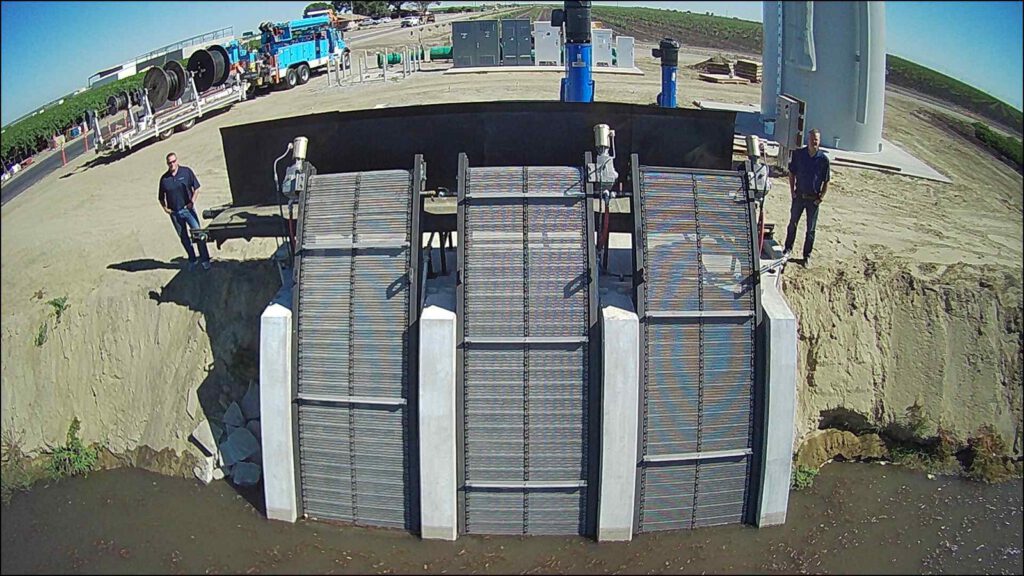California-based International Water Screens (IWS) creates custom-designed fish screens for irrigation districts and other canal managers. Its products meet the specific needs irrigation districts have for approach velocity, opening size, and flow level. IWS has sold its products both in the United States and in New Zealand.
In this interview, Rich Gargan, owner of IWS, speaks with Irrigation Leader Editor-in-Chief Kris Polly about how his company creates fish screens, from design to construction.
Kris Polly: Please tell us about your background and your company.
Rich Gargan: I’ve been in the screening industry for about 32–33 years now. Fish screens became popular around the early 1990s with the emergence of the environmental movement. We also manufacture traveling screens, which are designed with only debris removal in mind. We design our fish screens with different plastics and customize the size of the openings depending on the client’s requirements. Each fish screen is designed for a specific location.
All our fish screens are self-cleaning. If you put a screen with 3/32-inch openings in the water, it will catch debris like moss, leaves, and sticks. If you let it accumulate, the debris will plug the screen. Once that happens, the throughput velocity increases to the point that fish will start to impinge on the screen. It has to be self-cleaning to avoid that from happening.
Kris Polly: How many fish barriers or fish screens do you think you’ve designed and built?
Rich Gargan: Close to 50. A lot of times, we build what we think is a traveling screen, and after we put it in, the customer says, “Oh, by the way, this needs to work as a fish screen.” Then we have to make small changes so that it can also serve that purpose.
Kris Polly: What are the key design factors that irrigation districts or schemes should be aware of when creating a fish barrier?
Rich Gargan: The approach velocity that is required by law at its location is number 1. The size of the opening required at its location is number 2. The amount of flow, whether measured in cubic feet per second, gallons per minute, or gallons per day, is also important to know, as is water level. If the customer can give us that information, we can design a fish screen.

Kris Polly: What are the key steps from design to construction?
Rich Gargan: We need to know key criteria like flow rate, water level, opening size, and approach velocity. We also defer to the customer on what kinds of materials they want to use for their construction. They may require 304 or 316 stainless steel or a steel screen frame with stainless steel chains and belting. Those options can be mixed and matched in any way. The customers know what works best in their systems. Then we create a conceptual design. Once the customer is happy with the conceptual design, we give them a quote.
Kris Polly: Do you try to visit the site before you do a quote?
Rich Gargan: Yes, almost always.
Kris Polly: How long does building a fish barrier project generally take?
Rich Gargan: It’s probably 10 weeks from design to construction.
Kris Polly: What are the general maintenance requirements and life expectancy of a fish barrier?
Rich Gargan: The amount of general maintenance required is very low. You might need to do minor maintenance as infrequently as once every 10 years. The majority of fish screens have low approach velocity requirements, as low as 0.33 feet per second. That minimizes the wear on the screen.
The main maintenance required is removing the debris from behind the screen.
Kris Polly: How often do you need to change out the belting or mesh material used in the screen?
Rich Gargan: The belting should never need to be changed unless it is damaged by a catastrophic event. Normally, there is no wear on the belting itself. Theoretically, it should last just about forever. The only time that we have changed the belting out on a screen is when we went to a larger size. We installed a fish screen in Yuma that was designed for grass-eating carp that, at the time, were 12 inches long and 2 inches around. Now those carp are huge, probably 30 pounds, so we have been able to make the belt openings bigger.
Kris Polly: What do you think is most surprising to potential customers?
Rich Gargan: More often than not, when people contact us regarding fish screens, they’re shocked by how big and expensive the project ends up being. For instance, Chris Gargan is working on a project in Santa Paula right now where the client was running all its water through two of our normal traveling screens. Somebody was jogging one day by the screen and saw a dead fish on the bank that the screen had removed from the water. An environmentalist sued them, and now they are looking at 140 feet of screens rather than 8 feet. They have to go from an approach velocity of 4 feet per second down to 0.3 feet per second.
Joel Irving was working with someone in New Zealand who thought he needed a few screens. When we did the calculations to meet his requirements, he would have needed 36 screens, each 10 feet wide. When we tell people things like this, the first thing they do is they get mad at us because we’re delivering bad news. People need to understand that we are just designing screens to their specifications. In order to achieve the velocities required, you have to cover substantially more surface area than what you might think.
Rich Gargan is the owner of International Water Screens. He can be contacted at iwsrich@sbcglobal.net.
